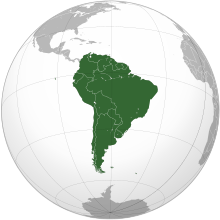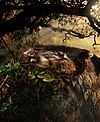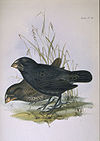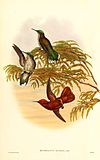List of South American animals extinct in the Holocene
Yi palo

Yuya zaŋ ti South America binkɔbiri ban lahi ka Holocene chanimi ni binkɔb'shɛba bɛ ni mi ka bɛ lahi ka South America tiŋgbani yaɣili yuma 12,000. Yuya maa chanimi ni binkɔbiri ban lahi ka Galápagos, Falklands, ni ko'sunsuuni tiŋgbana din baɣi lala yaɣili ŋɔ, amaa ka Easter Island ( Chile siyaasa yaɣ'shɛli) din kali m-pahi List of Oceanian animals extinct in the Holocene, bee Caribbean ko'sunsuuni tiŋgbana din be List of Antillian and Bermudan animals extinct in the Holocene.
Binnɛma ŋɔ shɛba ni ka ni saha shɛli nyɛla din bi mi.
Binnɛma ban dɔɣira
[mali niŋ | mali mi di yibu sheena n-niŋ]Talahi
[mali niŋ | mali mi di yibu sheena n-niŋ]- N.B.: Bɛ daa baŋ la binkɔbiri ŋɔ yɛla "from Late Pleistocene to Early Holocene" din depoziiti Brazil[1][2] ni Argentina,[3]amaa ka ni Holocene datation nini ni.
| Common name scientific name |
Range | Image |
|---|---|---|
| Ahytherium aureum | Bahia, Brazil | |
| Glyptotherium sp. | Florida and Texas to northeastern Brazil |  |
| Holmesina majus | Minas Gerais and Ceará, Brazil |  |
| Lestodon armatus | Southern Brazil |  |
| Neochoerus sp. | Middle Brazil |  |
| Nothrotherium maquinense | Eastern Brazil |  |
| Pachyarmatherium brasiliense | Eastern Brazil |  |
| Pampatherium sp. | Brazil |  |
| Panochthus tuberculatus | Luján, Buenos Aires, Argentina |  |
| Xenorhinotherium bahiense | North and east South America |
Pɔi ni taarihi
[mali niŋ | mali mi di yibu sheena n-niŋ]| Common name scientific name |
Extinction date | Range | Image |
|---|---|---|---|
| Dire wolf Aenocyon dirus |
7320-6840 BCE[4] | North America and western South America |  |
| Antifer ultra | c. 7950 BCE[5] | Río de la Plata Basin and central Chile | |
| Arctotherium tarijense | 8470-8320 BCE[6] | Argentina |  |
| Arctotherium wingei | 14825-6840 BCE[7] | Northeastern South America | |
| Catonyx cuvieri | 7830-7430 BCE[6] | Eastern South America |  |
| Cuvieronius hyodon | 9790 BCE[8] | Northern and central Andes |  |
| Doedicurus clavicaudatus | 4765-4445 BCE[9] | South American Pampas |  |
| Equus neogeus | 6660-4880 BCE[10] | South America |  |
| Eremotherium laurillardi | 7800-7740 BCE[11] | Southern United States to Brazil |  |
| Eutatus seguini | 6389-6060 BCE[12] | Northern Argentina and Uruguay |  |
| Glossotherium sp. | 6810-6650 BCE[10] | South America |  |
| Glyptodon sp.[upper-alpha 1] | 6660-4880 BCE[10] | Eastern South America |  |
| Hippidion saldiasi | 8059 BCE[14] | Eastern South America |  |
| Hoplophorus euphractus | 6660-4880 BCE[10] | Eastern Brazil |  |
| Macrauchenia patachonica | 9381-9281 BCE[15] | Southwestern South America |  |
| Giant ground sloth Megatherium americanum |
5270-4310 BCE[9] | Temperate South America and the Andes |  |
| Morenelaphus brachyceros | 8050-5845 BCE[16] | Temperate South America | |
| Darwin's ground sloth Mylodon darwini |
6689 BCE[17] | Pampas and Patagonia |  |
| Neosclerocalyptus paskoensis | 5120 BCE[13] | Southern South America |  |
| Notiomastodon platensis | 4170-4050 BCE[18] | South America |  |
| Palaeolama major | 6660-4880 BCE[10] | North and east South America | |
| Panthera onca mesembrina | 9705-9545 BCE[6] | Patagonia |  |
| Propraopus sulcatus | 6660-4880 BCE[10] | Eastern South America | |
| Scelidodon chiliensis | 7160-6760 BCE[10] | Western South America |  |
| Scelidotherium leptocephalum | 5660-5540 BCE[19] | Southern South America |  |
| South American saber-toothed cat Smilodon populator |
7330-7030 BCE[10] | Eastern South America |  |
| Toxodon platensis | 4650-1450 BCE[10] | South America |  |
| Valgipes bucklandi | 9110-9030 BCE[20] | Intertropical region of Brazil[1] |  |
Saha ŋɔ
[mali niŋ | mali mi di yibu sheena n-niŋ]| Common name scientific name |
Extinction date | Range | Image |
|---|---|---|---|
| Red-bellied gracile opossum Cryptonanus ignitus |
1962[21] | Jujuy, Argentina | |
| Giant vampire bat Desmodus draculae |
1675-1755[22] | Eastern South America | |
| Falkland Islands wolf Dusicyon australis |
1876[23] | Falkland Islands |  |
| Dusicyon avus | 1454-1626[24] | Argentina and Uruguay |  |
| Candango mouse Juscelinomys candango |
1960[25] | Brasilia, Brazil |  |
| Chilihueque Lama cf. guanicoe |
17th century[26] | Mocha Island, Chile |  |
| Fuegian dog Lycalopex cf. culpaeus |
20th century[27] | Tierra del Fuego |  |
| Galápagos giant rat Megaoryzomys curioi |
1520-1950[28] | Santa Cruz, Galápagos Islands, Ecuador |  |
| Caribbean monk seal Neomonachus tropicalis |
17th century[29] | Caribbean Sea, Bahamas, and Gulf of Mexico |  |
| Darwin's Galápagos mouse Nesoryzomys darwini |
1930[30] | Santa Cruz, Galápagos Islands, Ecuador | |
| Indefatigable Galápagos mouse Nesoryzomys indefessus |
1934[31] | Santa Cruz and Baltra, Galápagos Islands, Ecuador | |
| Vespucci's giant rat Noronhomys vespuccii |
1503[32] | Fernando de Noronha Island, Brazil |
| Common name scientific name |
Extinction date | Range |
|---|---|---|
| Zuniga's dark rice rat Melanomys zunigae |
1949[33] | Lomas de Atocongo, near Lima, Peru |
| One-striped opossum Monodelphis unistriata |
1899[34] | Southeastern Brazil and northeastern Argentina |
| Pacific degu Octodon pacificus |
1994[35] | Mocha Island, Chile |
Noonsi
[mali niŋ | mali mi di yibu sheena n-niŋ]| Common name scientific name |
Extinction date | Range | Image |
|---|---|---|---|
| Niceforo's pintail Anas georgica niceforoi |
1952[36] | Central Colombia | |
| Magdalena tinamou Crypturellus erythropus saltuarius |
1990s[36] | Magdalena River Valley, Colombia | |
| Darwin's ground finch Geospiza magnirostris magnirostris |
1835[36] | Floreana and San Cristóbal, Galápagos Islands, Ecuador |  |
| Antioquia brown-banded antpitta Grallaria milleri gilesi |
1878[36] | Santa Helena, Antioquia Department, Colombia | |
| Bogotá sunangel Heliantelus zusii |
1909[36] | Northern Andes? | |
| Alagoas foliage-gleaner Philydor novaesi |
2011[36] | Alagoas and Pernambuco, Brazil | |
| Colombian grebe Podiceps andinus |
1977[37] | Bogotá wetlands, Colombia | |
| San Cristóbal flycatcher Pyrocephalus dubius |
1987[38] | San Cristóbal, Galápagos Islands, Ecuador | |
| Peruvian rail Rallus semiplumbeus peruvianus |
1886[36] | Peruvian highlands and possibly Ecuador | |
| Alejandro Selkirk Island firecrown Sephanoides fernandensis leyboldi |
1908[36] | Alejandro Selkirk Island?, Juan Fernández Archipelago, Chile |  |
| Common name scientific name |
Extinction date | Range | Image |
|---|---|---|---|
| Glaucous macaw Anodorhynchus glaucus |
2001[39] | Border area of Argentina, Brazil, Paraguay, and Uruguay |  |
| Letitia's thorntail Discosura letitiae |
1852[36] | Bolivia |  |
| Turquoise-throated puffleg Eriocnemis godini |
1850[40] | Northern Ecuador |  |
| Eskimo curlew Numenius borealis |
1939[41] | Northwestern Canada and Alaska, and Southern Cone |  |
| Sinú parakeet Pyrrhura subandina |
1949[42] | Sinú Valley, Córdoba Department, Colombia |
| Common name scientific name |
Extinction date | Range | Reintroduction | Image |
|---|---|---|---|---|
| Spix's macaw Cyanopsitta spixii |
2000[43] | Sao Francisco River, Bahia, Brazil |  | |
| Alagoas curassow Mitu mitu |
1988[44] | Alagoas and Pernambuco, Brazil | 2019[45] |  |
Ban be kom ni
[mali niŋ | mali mi di yibu sheena n-niŋ]| Common name scientific name |
Extinction date | Range | Image |
|---|---|---|---|
| Pinta Island tortoise Chelonoidis abingdonii |
2012[46] | Pinta, Galápagos Islands, Ecuador |  |
| Floreana giant tortoise Chelonoidis niger |
c. 1850[47] | Floreana, Galápagos Islands, Ecuador |  |
Ban be kom ni mini duli
[mali niŋ | mali mi di yibu sheena n-niŋ]| Common name scientific name |
Extinction date | Range |
|---|---|---|
| Maracay harlequin frog Atelopus vogli |
1957[48] | Güey River, Aragua, Venezuela |
| Spiny-knee leaf frog Phrynomedusa fimbriata |
1898[49] | Paranapiacaba, State of Sao Paulo, Brazil |
| Common name scientific name |
Extinction date | Range |
|---|---|---|
| Green and red venter harlequin toad Atelopus pinangoi |
1997[50] | Mérida state, Venezuela |
| Aragua robber frog Pristimantis anotis |
1974[51] | Henri Pittier National Park, Aragua, Venezuela |
| Chile Darwin's frog Rhinoderma rufum |
1981[52] | Valparaíso and Biobío Regions, Chile |
Zahim
[mali niŋ | mali mi di yibu sheena n-niŋ]| Common name scientific name |
Extinction date | Range | Image |
|---|---|---|---|
| Galápagos damsel Azurina eupalama |
1982-1983[53] | Galápagos Islands, Ecuador |  |
| Titicaca orestias Orestias cuvieri |
unknown[54] | Lake Titicaca |  |
| Greasefish Rhizosomichthys totae |
1958[55] | Tota Lake, Colombia |  |
Echinoderms
[mali niŋ | mali mi di yibu sheena n-niŋ]| Common name scientific name |
Extinction date | Range |
|---|---|---|
| 24-rayed sunstar Heliaster solaris |
1983[56] | Galápagos Islands, Ecuador |
Binnɛma
[mali niŋ | mali mi di yibu sheena n-niŋ]| Common name scientific name |
Range |
|---|---|
| Megadytes ducalis | Brazil[57] |
| Rhantus orbignyi | Argentina and Brazil[58] |
Sambara
[mali niŋ | mali mi di yibu sheena n-niŋ]| Common name scientific name |
Extinction date | Range |
|---|---|---|
| Rhinodrilus fafner | 1912[59] | Belo Horizonte, Minas Gerais, Brazil |
Molluscs
[mali niŋ | mali mi di yibu sheena n-niŋ]| Common name scientific name |
Range | Image |
|---|---|---|
| Littoridina gaudichaudii | Ecuador[60] | Lahabali kɔligu:Littoridina gaudichaudii 2.png |
| Megalobulimus cardosoi | Brazil[61] | |
| Tomigerus gibberulus | Brazil[62] | |
| Tomigerus turbinatus | Brazil[63] |  |
| Common name scientific name |
Range |
|---|---|
| Aylacostoma chloroticum | Paraná River[64] |
Lahi Lihimi m-pahi
[mali niŋ | mali mi di yibu sheena n-niŋ]Noosi
[mali niŋ | mali mi di yibu sheena n-niŋ]- 1 2 da Silva, R. C., Berbert-Born, M., Bustamante, D. E. F., Santoro, T. N., Sedor, F., & dos Santos Avilla, L. (2019). "Diversity and preservation of Pleistocene tetrapods from caves of southwestern Bahia, Brazil". Journal of South American Earth Sciences, 90, 233-254.
- 1 2 Ghilardi, A. M., Fernandes, M. A., & Bichuette, M. E. (2011). "Megafauna from the Late Pleistocene-Holocene deposits of the Upper Ribeira karst area, southeast Brazil". Quaternary International, 245 (2), 369-378.
- 1 2 Fariña, R. A., Vizcaíno, S. F., & Bargo, M. S. (1998). "Body mass estimations in Lujanian (late Pleistocene-early Holocene of South America) mammal megafauna". Mastozoología Neotropical, 5 (2), 87-108.
- ↑ Prevosti, F. J., Tonni, E. P., & Bidegain, J. C. (2009). "Stratigraphic range of the large canids (Carnivora, Canidae) in South America, and its relevance to quaternary biostratigraphy". Quaternary International, 210 (1-2), 76-81.
- ↑ Labarca, R., & Alcaraz, M. A. (2011). "Presencia de Antifer ultra Ameghino (= Antifer niemeyeri Casamiquela)(Artiodactyla, Cervidae) en el Pleistoceno tardío-Holoceno temprano de Chile central (30-35° S)". Andean Geology, 38 (1), 156-170.
- 1 2 3 Haynes, Gary (2009). American Megafaunal Extinctions at the End of the Pleistocene. Springer. ISBN 978-1-4020-8792-9. Retrieved 28 February 2012.
- ↑ Rincón, A. D., & Soibelzon, L. H. (2007). "The fossil record of the short-faced bears (Ursidae, Tremarctinae) from Venezuela. Systematic, biogeographic, and paleoecological implications". Neues Jahrbuch für Geologie und Paläontologie, 244.
- ↑ Correal Urrego, G. et al. (1990). "Evidencias culturales durante el Pleistoceno y Holoceno de Colombia". Revista de Arqueología Americana, 1, 68-69.
- 1 2 Gutiérrez, M.A. et al. (2010). "Supervivencia diferencial de mamíferos de gran tamaño en la región pampeana en el Holoceno temprano y su relación con aspectos paleobiológicos". In Zooarqueología a principios del siglo XXI: Aportes teóricos, metodológicos y casos de estudio. Ediciones del Espinillo, Buenos Aires, 231-242.
- 1 2 3 4 5 6 7 8 9 Turvey, Sam (2009). Holocene Extinctions. Oxford University Press. ISBN 978-0-19-953509-5. Retrieved 29 February 2012.
- ↑ Dantas, M.A.T., & Cozzuol, M.A. (2016). "The Brazilian intertropical fauna from 60 to about 10 ka BP: taxonomy, dating, diet, and Paleoenvironments". In Marine Isotope Stage 3 in Southern South America, 60 KA BP-30 KA BP, pages 207-226.
- ↑ Stuart, A.J. (2021) Vanished Giants: The Lost World of the Ice Age. University of Chicago Press, 288 pages.
- 1 2 Zurita, A. E. (2007). Sistemática y evolución de los Hoplophorini (Xenarthra: glyptodontidae: hoplophorinae. Mioceno tardío-Holoceno temprano). Importancia bioestratigráfica, paleobiogeográfica y paleoambiental. (Doctoral dissertation, Universidad Nacional de La Plata).
- ↑ Barnosky, A. D., & Lindsey, E. L. (2010). "Timing of Quaternary megafaunal extinction in South America in relation to human arrival and climate change". Quaternary International, 217 (1-2), 10-29.
- ↑ Prado, J. L., Martinez-Maza, C., & Alberdi, M. T. (2015). "Megafauna extinction in South America: A new chronology for the Argentine Pampas". Palaeogeography, Palaeoclimatology, Palaeoecology, 425, 41-49.
- ↑ Ubilla, M., et al. (2018). "Mammals in last 30 to 7 ka interval (Late Pleistocene-Early Holocene) in southern Uruguay (Santa Lucía River Basin): last occurrences, climate, and biogeography". Journal of Mammalian Evolution, 25(2), 291-300.
- ↑ Martin, Paul S.; Klein, Richard G. (1989). Quaternary Extinctions: A Prehistoric Revolution. University of Arizona Press. ISBN 978-0-231-03733-4.
- ↑ Rodríguez-Flórez, C. D., Rodríguez-Flórez, E. L., & Rodríguez, C. A. (2009). "Revisión de la fauna pleistocénica Gomphotheriidae en Colombia y reporte de un caso para el Valle del Cauca. Boletín Científico. Centro de Museos". Museo de Historia Natural, 13 (2), 78-85.
- ↑ Cruz, L. E., Bargo, M. S., Tonni, E. P., & Figini, A. J. (2010). "Radiocarbon date on megafauna from the late Pleistocene-early Holocene of Córdoba province, Argentina: stratigraphic and paleoclimatic significance". Revista Mexicana de Ciencias Geológicas, 27 (3), 470-476.
- ↑ Miño-Boilini, Á. R., & Quiñones, S. I. (2020). "Los perezosos Scelidotheriinae (Xenarthra, Folivora): taxonomía, biocronología y biogeografía". Revista del Museo Argentino de Ciencias Naturales, 22 (2), 201-218.
- ↑ Flores, D. (2016). "Cryptonanus ignitus". IUCN Red List of Threatened Species 2016. DOI:10.2305/IUCN.UK.2016-2.RLTS.T41320A22177809.en.
- ↑ Pardiñas, U.F.J., & Tonni, E.P. (2000). "A giant vampire (Mammalia, Chiroptera) in the Late Holocene from the Argentinean pampas: paleoenvironmental significance". Palaeogeography, Palaeoclimatology, Palaeoecology, 160 (3-4), 213-221.
- ↑ Sillero-Zubiri, C. (2015). "Dusicyon australis". IUCN Red List of Threatened Species 2015. DOI:10.2305/IUCN.UK.2015-4.RLTS.T6923A82310440.en.
- ↑ (November 2015) "Extinctions in near time: new radiocarbon dates point to a very recent disappearance of the South American fox Dusicyon avus (Carnivora: Canidae)". Biological Journal of the Linnean Society 116 (3): 704–720. DOI:10.1111/bij.12625.
- ↑ Roach, N. (2019). "Juscelinomys candango". IUCN Red List of Threatened Species 2019. DOI:10.2305/IUCN.UK.2019-3.RLTS.T10946A160756258.en.
- ↑ Westbury, M., Prost, S., Seelenfreund, A., Ramírez, J. M., Matisoo-Smith, E. A., & Knapp, M. (2016). "First complete mitochondrial genome data from ancient South American camelids-the mystery of the chilihueques from Isla Mocha (Chile)". Scientific Reports, 6 (1), 1-7.
- ↑ Silva Rochefort, B., & Root‐Bernstein, M. (2021). "History of canids in Chile and impacts on prey adaptations". Ecology and Evolution, 11 (15), 9892-9903.
- ↑ Weksler, M. (2019). "Megaoryzomys curioi". IUCN Red List of Threatened Species 2019. DOI:10.2305/IUCN.UK.2019-1.RLTS.T136657A22330270.en.
- ↑ McClenachan, L., & Cooper, A. B. (2008). "Extinction rate, historical population structure and ecological role of the Caribbean monk seal". Proceedings of the Royal Society B: Biological Sciences, 275(1641), 1351-1358.
- ↑ Tirira, D.G. (2019). "Nesoryzomys darwini". IUCN Red List of Threatened Species 2019. DOI:10.2305/IUCN.UK.2019-3.RLTS.T14706A22390382.en.
- ↑ Tirira, D.G. (2019). "Nesoryzomys indefessus". IUCN Red List of Threatened Species 2019. DOI:10.2305/IUCN.UK.2019-1.RLTS.T14708A22390443.en.
- ↑ Weksler, M. (2019). "Noronhomys vespuccii". IUCN Red List of Threatened Species 2019. DOI:10.2305/IUCN.UK.2019-1.RLTS.T136692A22333193.en.
- ↑ Zeballos, H. (2019). "Melanomys zunigae". IUCN Red List of Threatened Species 2019. DOI:10.2305/IUCN.UK.2019-1.RLTS.T13048A22344408.en.
- ↑ Pavan, S. (2016). "Monodelphis unistriata". IUCN Red List of Threatened Species 2016. DOI:10.2305/IUCN.UK.2016-3.RLTS.T13703A22171555.en.
- ↑ Roach, N. (2016). "Octodon pacificus". IUCN Red List of Threatened Species 2016. DOI:10.2305/IUCN.UK.2016-2.RLTS.T15090A78321512.en.
- 1 2 3 4 5 6 7 8 9 Hume, J.P. (2017) Extinct Birds. Bloomsbury Publishing, 560 pages.
- ↑ BirdLife International (2016). "Podiceps andinus". IUCN Red List of Threatened Species 2016. DOI:10.2305/IUCN.UK.2016-3.RLTS.T22696615A93574182.en.
- ↑ BirdLife International (2017). "Pyrocephalus dubius". IUCN Red List of Threatened Species 2017. DOI:10.2305/IUCN.UK.2017-3.RLTS.T103682916A119211257.en.
- ↑ BirdLife International (2019). "Anodorhynchus glaucus". IUCN Red List of Threatened Species 2019. DOI:10.2305/IUCN.UK.2019-3.RLTS.T22685527A154380861.en.
- ↑ BirdLife International (2020). "Eriocnemis godini". IUCN Red List of Threatened Species 2020. DOI:10.2305/IUCN.UK.2020-3.RLTS.T22687922A182244989.en.
- ↑ BirdLife International (2019). "Numenius borealis". IUCN Red List of Threatened Species 2019. DOI:10.2305/IUCN.UK.2019-3.RLTS.T22693170A155293606.en.
- ↑ BirdLife International (2016). "Pyrrhura subandina". IUCN Red List of Threatened Species 2016. DOI:10.2305/IUCN.UK.2016-3.RLTS.T45422401A95151315.en.
- ↑ BirdLife International (2019). "Cyanopsitta spixii ". IUCN Red List of Threatened Species 2019.
- ↑ BirdLife International (2018). Mitu mitu. The IUCN Red List of Threatened Species 2018: e.T22678486A132315266. https://dx.doi.org/10.2305/IUCN.UK.2018-2.RLTS.T22678486A132315266.en. Retrieved 4 April 2022.
- ↑ Francisco, M. R., Costa, M. C., Azeredo, R. M., Simpson, J. G., da Costa Dias, T., Fonseca, A., ... & Silveira, L. F. (2021). "Recovered after an extreme bottleneck and saved by ex situ management: Lessons from the Alagoas curassow (Pauxi mitu [Linnaeus, 1766]; Aves, Galliformes, Cracidae)". Zoo Biology, 40 (1), 76-78.
- ↑ Cayot, L.J. (2016). "Chelonoidis abingdonii". IUCN Red List of Threatened Species 2016. DOI:10.2305/IUCN.UK.2016-1.RLTS.T9017A65487433.en.
- ↑ van Dijk, P.P. (2017). "Chelonoidis niger". IUCN Red List of Threatened Species 2017. DOI:10.2305/IUCN.UK.2017-3.RLTS.T9023A3149101.en.
- ↑ IUCN SSC Amphibian Specialist Group (2020). "Atelopus vogli". IUCN Red List of Threatened Species 2020. DOI:10.2305/IUCN.UK.2020-3.RLTS.T54561A109529582.en.
- ↑ Baêta, D., Giasson, L. O. M., Pombal Jr, J. P., & Haddad, C. F. B. (2016). "Review of the rare genus Phrynomedusa Miranda-Ribeiro, 1923 (Anura: Phyllomedusidae) with description of a new species". Herpetological Monographs, 30 (1), 49-78.
- ↑ La Marca, E. (2004). "Atelopus pinangoi". IUCN Red List of Threatened Species 2004. DOI:10.2305/IUCN.UK.2004.RLTS.T54542A11164544.en.
- ↑ IUCN SSC Amphibian Specialist Group (2020). "Pristimantis anotis". IUCN Red List of Threatened Species 2020. DOI:10.2305/IUCN.UK.2020-3.RLTS.T56423A109538689.en.
- ↑ IUCN SSC Amphibian Specialist Group (2015). "Rhinoderma rufum". IUCN Red List of Threatened Species 2015. DOI:10.2305/IUCN.UK.2015-4.RLTS.T19514A79809567.en.
- ↑ (2010) "Azurina eupalama". The IUCN Red List of Threatened Species 2010. DOI:10.2305/IUCN.UK.2010-3.RLTS.T184017A8219600.en.
- ↑ World Conservation Monitoring Centre (1996). "Orestias cuvieri". IUCN Red List of Threatened Species 1996. DOI:10.2305/IUCN.UK.1996.RLTS.T15491A4665163.en.
- ↑ Mesa-Salazar, L. (2016). "Rhizosomichthys totae". IUCN Red List of Threatened Species 2016. DOI:10.2305/IUCN.UK.2016-1.RLTS.T19661A61472482.en.
- ↑ Alvarado, J.J. & Solis-Marin, F.A. (2012). Echinoderm Research and Diversity in Latin America. Springer Science & Business Media.
- ↑ World Conservation Monitoring Centre (1996). "Megadytes ducalis". IUCN Red List of Threatened Species 1996. DOI:10.2305/IUCN.UK.1996.RLTS.T12944A3400572.en.
- ↑ World Conservation Monitoring Centre (1996). "Rhantus orbignyi". IUCN Red List of Threatened Species 1996. DOI:10.2305/IUCN.UK.1996.RLTS.T19461A8894689.en.
- ↑ Moreira, F.M.S. et al. (2006). Soil Diversity in Amazonian and Other Brazilian Ecosystems. CABI, 280 pages.
- ↑ IUCN
- ↑ IUCN
- ↑ IUCN
- ↑ IUCN
- ↑ Mansur, M.C.D. (2000). "Aylacostoma chloroticum". IUCN Red List of Threatened Species 2000. DOI:10.2305/IUCN.UK.2000.RLTS.T29612A9504703.en.
References
[mali niŋ | mali mi di yibu sheena n-niŋ]External links
[mali niŋ | mali mi di yibu sheena n-niŋ]Tɛmplet:Extinct Animals by Regions
- ↑ The species Glyptodon reticulatus is known from the Late Pleistocene-Early Holocene of southeast Brazil and Buenos Aires province, Argentina;[3] G. clavipes from southeast Brazil,[2] and G. ornatus from Argentina, Uruguay, Paraguay, and Bolivia.[13]A chirim ya:
&It;ref>tuma maa yi laɣingu din yuli nyɛ "upper-alpha", ka lee bi saɣiritiri$It;references group ="upper-alpha"/>tuka maa bon nya
Pubu pubu:
- Articles with short description
- Short description with empty Wikidata description
- Holocene extinctions
- Extinct animals of South America
- Quaternary animals of South America
- Lists of extinct animals by continent
- South America-related lists
- Lists of animals of South America
- Yaɣa din mali gadama ni lahabali konjɔɣu soya
- Peejinima din kundivira bi viɛla
- Pages with reference errors that trigger visual diffs
